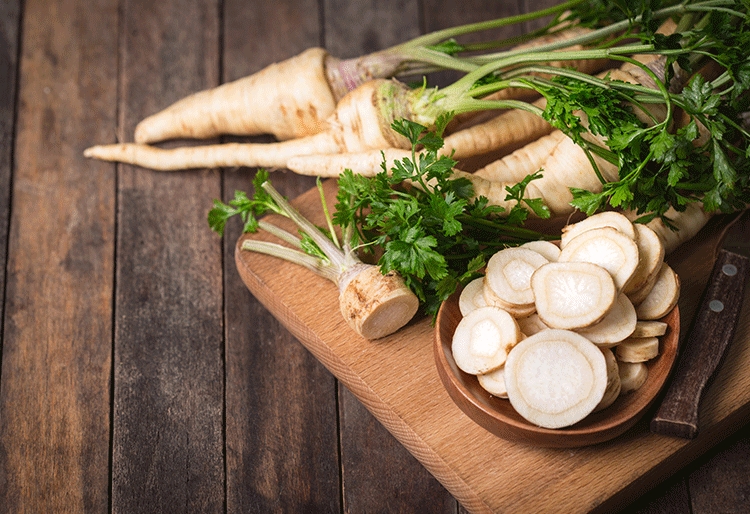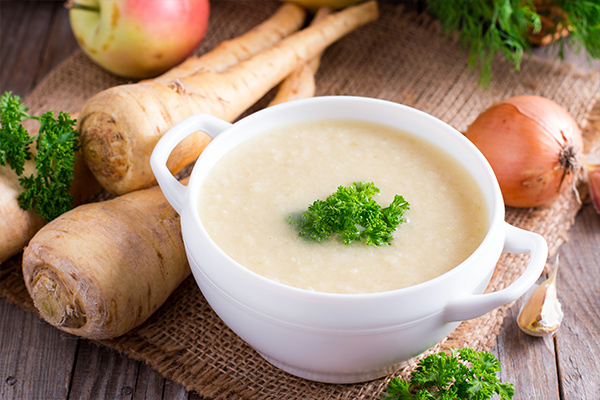The Properties of the Parsnip
Do you know the properties of parsnip? Also known as parsnip, parsnip is a vegetable packed with health benefits. Discover everything it has to offer you and take note of the following ideas to prepare it in the kitchen.
TRIED AND TESTED
Share

What is parsnip?
Parsnips are a root vegetable native to Asia and Europe that are very similar to carrots, but with a cream or ivory hue and an anise-like flavor. Although it is currently less popular than other vegetables, parsnip was for centuries an indispensable food among the humblest families.
Before the introduction of the potato to Europe after the discovery of America, the parsnip took its place and was one of the main sources of food for the people. It was used in stews, soups, stews, purées, roasts and steamed, a great protagonist in the cuisine of the time thanks to its light flavor. However, with the arrival of the potato, the parsnip fell into the background, despite being a food with significant nutritional value and a long list of properties.
Although today we can consume it throughout the year, the parsnip season is autumn-winter. In certain parts of the world it grows wild, but in Spain its cultivation is limited to the north and to mountainous areas in the center and east.
Benefits and properties of parsnip
Among the most outstanding parsnip properties we can find:
High content of vitamins:
- Vitamin E: has an antioxidant effect and helps the body's cells from oxidative stress and thus helps reduce the chances of contracting degenerative eye diseases such as cataracts.
- Vitamin K: helps the body maintain healthy bones and tissues. In addition, it contributes to the generation of proteins that help the blood to coagulate correctly.
- Vitamin B9 or folic acid: highly recommended for women during pregnancy and lactation, as they help prevent certain diseases in the formation and growth of the baby.
- Vitamin C: helps to correct tissue healing, but also to repair and maintain cartilage, bones and teeth. In addition, it helps the absorption of minerals such as iron.
Source of minerals: such as potassium, which contributes to muscle activity and to maintaining adequate blood pressure.
Excellent source of fiber: a fact that makes it a very effective remedy against constipation, thus helping the proper functioning of the digestive system. In addition, it is a powerful diuretic that helps prevent fluid retention.
Source of essential fatty acids: such as Omega 3 acid and Omega 6 acid, which are essential components for cell formation. In addition, they are precursors for the formation of many other substances in the body, such as those involved in the regulation of blood pressure and the body's inflammatory responses. These essential fatty acids also help the heart function properly, thus helping to prevent heart disease.
Low in calories: among the properties of parsnip we can find that it is a very light food, since this vegetable only contains 75 kcal per 100 g.

Recipes with parsnip
Parsnip gives dishes an aniseed touch, with a slight spicy nuance and a delicious fresh flavor that is perceived from the moment we cook it. Today the parsnip is used above all in stews and soups, one of the best known being the Valencian stew, but there are many other ways to prepare it, since the parsnip is a very versatile vegetable that can be used in many other récipes. Take note of these 3 parsnip recipes that we have prepared for you!
Parsnip and leek cream
One of the most delicious ways to consume and preserve the properties of parsnip is to prepare it in creams or purees. We can combine it with other vegetables such as pumpkin, courgette or leek to get a delicious recipe... And full of vitamins!
Ingredients
- 2 or 4 carrots, peeled and sliced (depending on their size)
- ½ sweet onion cut into quarters
- 1 leek cut into slices
- 4 or 5 cups of vegetable broth
- A handful of toasted and peeled almonds
- 2 or 3 parsnips, peeled and cut into sticks (depending on their size)
- ½ tablespoon ground cumin
- ½ tablespoon of turmeric
- Salt
- Extra virgin olive oil
Preparation
- Wash and cut the vegetables into small pieces. Reserve the parsnip and separate it from the rest.
- With the exception of the parsnips, place the vegetables in a saucepan with 4 cups of broth (or as many as necessary until all the vegetables are covered). When it starts to boil, add the salt, lower the heat and let the vegetables cook for about 25 minutes or until they are soft. Turn off the heat and reserve the vegetables and the cooking broth.
- In a bowl prepare a sauce with the oil, salt and spices. Spread the parsnip with the spiced sauce and bake it for 20 or 30 minutes at 180º.
- When the parsnip is ready, add it to the pot along with the rest of the vegetables and the almonds. Blend everything until you get a smooth, lump-free puree. If the puree is too thick, you can add vegetable broth to thin it out a bit more.
Baked parsnip sticks with honey
Another way to prepare this vegetable is in the oven, which makes it an ideal snack for a healthy snack.
Ingredients
- 6 parsnips
- Mix of aromatic herbs: oregano, rosemary, thyme, herbs de Provence, etc.
- Virgin olive oil
- Honey
- Salt
Preparation
- Wash and peel the parsnips and cut them into sticks.
- Put the sticks on a baking tray, previously lined with baking paper.
- In a bowl, prepare a sauce with your favorite aromatic herbs, olive oil and honey. Reserve some sauce for later.
- Spread the sticks with the sauce and pour a little salt on top.
- Bake the parsnip for 30 minutes at 200º. eye! turn occasionally to cook all sides evenly and crisp.
- Take the canes out of the oven… And enjoy!

Parsnip hummus with garlic oil
Ingredients for the hummus
- 6 parsnips, peeled and chopped
- 60 ml of extra virgin olive oil
- ½ tablespoon ground cumin
- ½ tablespoon ground coriander
- Salt
- 2 large garlic cloves, minced
- 6 tablespoons of Tahini
- 4 freshly squeezed lemon juice
- 120 ml of chicken broth or water (depending on taste)
Ingredients for garlic oil
- 4 tablespoons of virgin olive oil
- 1 clove of minced or minced garlic
- Ground black pepper to taste
- Cayenne ground to taste
Preparation
- Wash and peel the parsnips and place them in a pot along with the water (or broth) and spices. Cook over low heat about 15 minutes or until soft.
- Prepare the garlic oil by mixing the ingredients.
- Remove the parsnips from the heat and blend them with the tahini, garlic and lemon juice. If it is too thick, you can add a couple of tablespoons of broth or water.
- Serve the parsnip hummus in a bowl with the garlic oil on top.
- Dip with your favorite snack! Are you into veggie crudité or Doritos?






